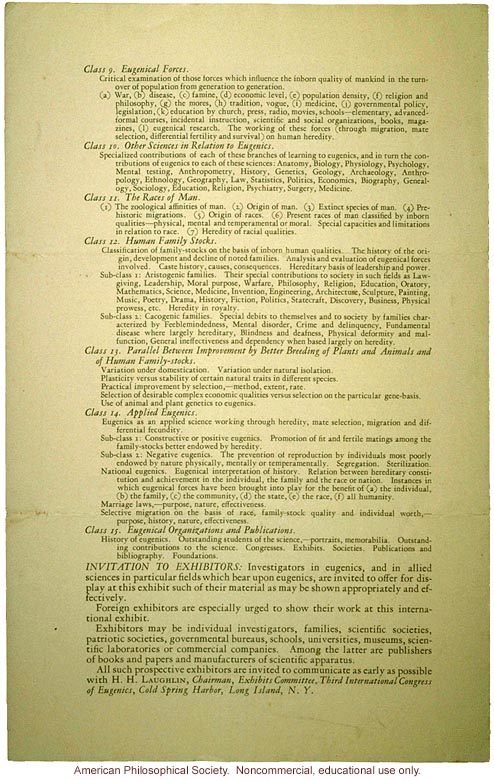The exhibit of the Third International Congress of Eugenics (3)

The exhibit of the Third International Congress of Eugenics (3)
491. Class 9. Eugenical Forces. Critical examination of those forces which influence the inborn quality of mankind in the turn-over of population from generation to generation. (a) War, (b) disease, (c ) famine, (d) economic level, (e) population density, (f) religion and legislation, (g) the mores, (h) tradition, vogue, (i) medicine, (j) governmental policy, (k) education by church, press, radio, movies, schools - elementary, advanced formal courses, incidental instruction, scientific and social organizations, books, magazines, (l) eugenical research. The working of these forces (through migration, mate selection, differential fertility and survival) on human heredity. Class 10. Other Sciences in Relation to Eugenics. Specialized contribution of each of these branches of learning to eugenics, and in turn the contribution of eugenics to each of these sciences: Anatomy, Biology, Physiology, Psychology, Mental testing, Anthropometry, History, Genetics, Geology, Archeology, Anthropology, Ethnology, Geography, Law, Statistics, Politics, Economics, Biography, Genealogy, Sociology, Education, Religion, Psychiatry, Surgery, Medicine. Class 11. The Races of Man. (1) The zoological affinities of man. (2) Origin of man. (3) Extinct species of man. (4) Prehistoric migrations. (5) Origin of races. (6) Present races of man classified by inborn qualities - physical, mental and temperamental or moral. Special capacities and limitations in relation to race. (7) Heredity of racial qualities. Class 12. Human Family Stocks. Classification of family stocks on the basis of inborn, human qualities. The history of the origin, development and decline of noted families. Analysis and evaluation of eugenical forces involved. Caste history, causes, consequences. Hereditary traits of leadership and power. Sub-class 1: Aristogenic families. Their special contribution to society in such fields in Lawgiving, Leadership, Moral purpose, Warfare, Philosophy, Religion, Education, Oratory, Mathematics, Science, Medicine, Invention, Engineering, Architecture, Sculpture, Painting, Music, Poetry, Drama, History, Fiction, Politics, Statecraft, Discovery, Business, Physical prowess, etc. Heredity in royalty. Sub-class 2: Cacogenic families. Special debits to themselves and to society by families characterized by Feeblemindedness, Mental disorder, Crime and delinquency, Fundamental disease where largely hereditary, Blindness and deafness, Physical deformity and malfunction, General ineffectiveness and dependency when based largely on heredity. Class 13. Parallel Between Improvement by Better Breeding of Plants and Animals and of Human Family-stocks. Variation under domestication. Variation under actual isolation. Plasticity versus stability of certain natural traits in different species. Physical improvement by selection, -- method, extent, rate. Selection of desirable complex economic qualities versus selection on the particular gene-basis. Use of animal and plant genetics in relation to eugenics. Class 14. Applied Eugenics. Eugenics as an applied science working through heredity, mate selection, migration and differential fertility. Sub-class 1: Constructive or positive eugenics. Promotion of fit and fertile matings among the family-stocks better endowed by heredity. Sub-class 2: Negative eugenics. The prevention of reproduction by individuals most poorly endowed by nature physically, mentally or temperamentally. Segregation, Sterilization, National eugenics. Eugenical interpretation of history. Relation between constitution and achievement in the individual, the family and the race or nation. Instincts in which eugenical forces have been brought into play for the benefit of (a) the individual, (b) the family, (c ) the community, (d) the state, (e) the race, (f) all humanity. Marriage laws, -- purpose, nature, effectiveness. Selective migration on the basis of race, family-stock quality and individual worth, purpose, history, nature, effectiveness. Class 15. Eugenical Organizations and Publications. History of eugenics. Outstanding students of the science, -- portraits, memorabilia. Outstanding contributions to the science. Congress. Exhibits. Societies. Publications and bibliography. Foundations. Invitations to Exhibitors: Investigators in eugenics, and in allied sciences in particular fields which bear upon eugenics, are invited to offer for display at this exhibit such of their material as may be shown appropriately and effectively. Foreign exhibitors are especially urged to show their work at this international exhibit. Exhibitors may be individual investigators, families, scientific societies, patriotic societies, governmental bureaus, schools, universities, museums, scientific laboratories or commercial companies. Among the latter are publishers of books and papers and manufacturers of scientific apparatus. All such prospective exhibitors are invited to communicate as early as possible with H. H. Laughlin, Chairman, Exhibits Committee, Third International Congress of Eugenics, Cold Spring Harbor, Long Island, N. Y.
- ID: 10485
- Source: DNALC.EA


